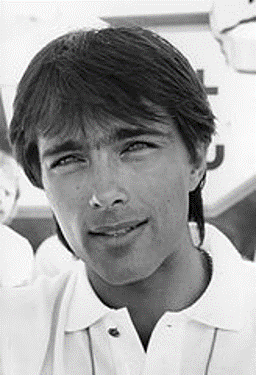Car racing took on the form of sporting rivalry at the end of the 19th century. The first race took place on 22 July 1894 in France, but no one received a first place prize. In 1906 the first competition in the Grand Prix (French: "Grand Prize") cycle was held. A Hungarian engineer and mechanic, Ferenc Szisz, entered the competition. It was the beginning of the Hungarians’ great car racing adventure, which continues to this day.
Ferenc Szisz (on the left) in 1914
Szisz was born on 20 September 1874 in Szeghalom (the town is located 180 km from Budapest and today boasts about 9 thousand residents). He studied engineering and was interested in automobiles. Thanks to his passion he came to Paris, where he was employed in the Renault Automobile testing department. When Marcel Renault, one of the founders, died in a race, Ferenc was chosen as the new driver. He first took part in the Gordon Benett Cup and then in the Venderbilt Cup rally in the United States. In both races he won a high, fifth place. Since he was an experienced mechanic, he used his knowledge of the workings of vehicles in his driving style - it was fast and used the full potential of the vehicle.
Statue of Ferenc Szisz at the main entrance of Hungaroring

Postage stamp issued in 2006 to commemorate the 100th anniversary of Ferenc Szisz’s victory in the first Grand Prix.
On 27-28 June 1906, among the fields and forests near the town of Le Mans in France, the first of a series of car races called "Grand Prix" was organized. The racecourse was over 103 kilometres long over dusty roads. The participants had to complete twelve laps. Ferenc Szisz entered the competition in a Renault AK90CV. Hungary was not a favourite. The bookmakers odds were 1 to 200 for him to, while on the Italian Vincenzio Lancie the odds were 1 to 10. However, after the third lap Szisz took the lead, which he held onto throughout the day. He wasn't willing to give it up the next day either, despite the fact that in the tenth lap his car suffered a rear suspension failure. Thus, he won the first ever Grand Prix with a time of 12 hours, 14 minutes and 7 seconds. He also achieved the highest maximum speed of the competition: 154 km/h. A black flag was waved for Szisz at the finish line - a sign of victory. In an interview after the race he said: "I was afraid that something small could take away the victory at a moment when it seemed like I would win.
Ferenc Szisz crossing the finish line in first place at the 1906 Grand Prix in France
Which behind the wheel of a Renault AK90CV
After the victory, Ferenc Szisz stood at the threshold of fame. In 1907 he won a very high, second place in the next French Grand Prix. He soon opened his own workshop, but continued to work with Renault. As a very experienced and valuable mechanic, he was no longer put out to race so as not to risk his life. After the outbreak of World War I, he served in the French army in Algeria, where he was a driver and a mechanic. In 1918 he was released from the army and moved to the country where he and his wife ran a large farm in the village of Auffargis, near Paris. He died of pneumonia on 21 February 1944 at the age of 71 and was buried at a local cemetery. Szisz is considered to be the first professional driver in the history of car racing.
Remnants of Ferenc Szisz are his museum, which is part of the Renault Museum located near the French Le Mans circuit. In 2003, a monument was erected in front of the new main entrance to the Hungaroring circuit in Budapest. On 4 August 2006, on the 100th anniversary of Szisz’s victory, his bust was unveiled on the square in front of the city's sports hall in Szeghalom and a permanent exhibition about him was opened.
On 21 June 1936, the first Grand Prix series races were held in Hungary. The 3.1-mile-long track was located in Budapest's National Park. The only representative of the hosts in the rally - Hartmann László – finished in seventh place..
1936 Hungarian Grand Prix
In 1950 the successor to the Grand Prix series was the Formula 1 World Championship. Due to the political situation after the end of World War II, Hungary stopped organising the most prestigious car racing event. Only in the early 1960s, Budapest hosted the Formula Junior and European Touring Car Championship series. In the early 1980s, Bernie Ecclestone, head of the FIA (an international NGO with 239 national car sports federations), decided to introduce Formula 1 behind the Iron Curtain.
Originally it was either Yugoslavia or the Soviet Union, but the decision-makers on both sides failed to reach an agreement. At that time, Tamas Rohonyi, who came from Budapest and worked with Ecclestone, proposed to build a new track in Hungary. The communist authorities of the country welcomed this idea. They considered adapting the People's Park, but finally decided to build a new separate facility.
200 thousand spectators on the hills surrounding the Hungaroring. Photograph: Urban Tamas, fortepan.hu.
The Valley of Three Springs, located 19 km from the centre of Budapest, was chosen as the location of the track called "Hungaroring". Work began in March 1985 on 73 hectares and lasted seven months. The architects Istvan Papp and Ferenc Gulacsi designed the track in such a way that there was excellent visibility from every seat on the stands. This was made possible by using a computer program for the first time in the world. The total construction cost was 340 million forints (about 17.5 million US dollars at the time). Interestingly, half of this amount was already recovered after the first Hungarian Grand Prix.
The track was opened in June 1986. The first Hungarian Formula 1 Grand Prix race took place on August 10. Despite the fact that the ticket price was several times higher than the average salary, 200 thousand fans arrived for the race. For fans living on the communist side of the "Iron Curtain" the Hungarian track was synonymous with life in the West and modernity. During the spectacle, the facility was guarded by soldiers and Soviet tanks were not far away, just in case. The sporting spectacle was broadcasted on TV around the world and was watched by around 400 million people, and the whole event was a huge success.
The racetrack was originally intended to last for up to 10 years. However, it was renovated and rebuilt several times. From 2014 to the present day, the Hungarians invested more than 120 million Euros in Hungaroring, which resulted in an extension of the contract for Formula 1 events until 2026. Only two F1 circuits (Monaco and Monza) have been hosting the world's best drivers for longer.
The track itself is technically very difficult. Narrow and winding, it has fourteen corners. In addition, dusty, bumpy road surfaces and frequent heat are a finishing touch for both drivers and their cars' tyres. The first rain in the history of the Hungarian Grand Prix only fell in 2006! One lap is 4.381 km long. With seventy laps the whole distance to be covered in one Formula 1 race is 306.663 km.
The first Hungarian test driver in F1 was Csaba Kesjár. He was born on 9 February 1962 in Budapest. First he competed in karting races, then he made his debut in German Formula 3. In 1987 he tested one of the cars of German racing team Zakspeeda. It was the premiere performance of a Hungarian driver in Formula 1. Kesjár died in an accident in 1988 on the Nuremberg circuit. During the race, his vehicle suffered a brake system failure and at a speed of 200 km/h he hit a wall of tyres. In 1992, one of the primary schools in Budaörs (a town near Budapest) was named after him.

Csaba Kesjár
The only Hungarian who managed to become the first driver in Formula 1 is Zsolt Baumgartner. He was born on 1 January 1981 in Debrecen. He made his debut at Hungaroring in 2003. He has participated in a total of twenty races and his greatest success was to take eighth place in one of the races. Currently, Baumgartner is no longer an active driver, but still works with the FIA.
Formula One races are as important and exciting for Hungarians as ski jumping is for Poles. For some of them it's an unwritten tradition to come to Hungaroring once a year. Also for fans from the banks of the Vistula River this place is unique, not only because of its proximity. It was here that Robert Kubica made his debut in the 2006 season, finishing in seventh place (after the race he was disqualified due to an incorrect weight of his car). Currently one of the stands of the facility is called the "Kubica Grandstand" in honour of the first Polish Formula 1 driver.
Sources:
David Hodges, The French Grand Prix, 1906-1966.
Official F1 website - www.formula1.com
Official Hungaroring website: www.hungaroring.hu
Official Hungarian Grand Prix Website: www.hungaroinfo.com/formel1/index_pl.htm
f1wm.pl
f1ultra.pl

Michał Kawęcki, urodzony w 1987 roku. Politolog, założyciel i prezes Stowarzyszenia Sympatyków I. Lwowskiego Klubu Sportowego Czarni Lwów. Autor monografii najstarszego polskiego klubu piłkarskiego.
